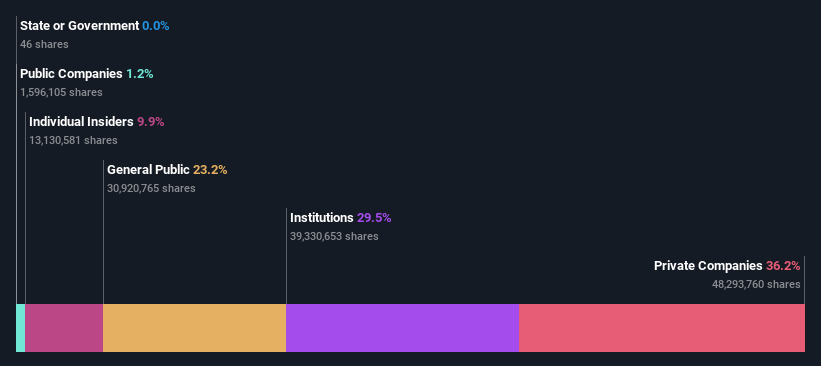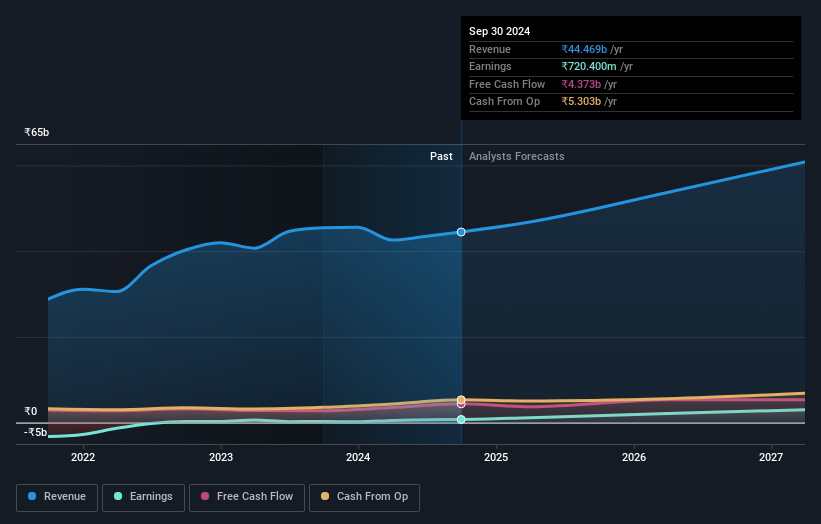- India
- /
- Specialty Stores
- /
- NSEI:ARVINDFASN
Painful week for private companies invested in Arvind Fashions Limited (NSE:ARVINDFASN) after 6.3% drop, institutions also suffered losses

Key Insights
- Arvind Fashions' significant private companies ownership suggests that the key decisions are influenced by shareholders from the larger public
- The top 7 shareholders own 51% of the company
- Institutions own 30% of Arvind Fashions
A look at the shareholders of Arvind Fashions Limited (NSE:ARVINDFASN) can tell us which group is most powerful. We can see that private companies own the lion's share in the company with 36% ownership. That is, the group stands to benefit the most if the stock rises (or lose the most if there is a downturn).
Following a 6.3% decrease in the stock price last week, private companies suffered the most losses, but institutions who own 30% stock also took a hit.
Let's take a closer look to see what the different types of shareholders can tell us about Arvind Fashions.
View our latest analysis for Arvind Fashions

What Does The Institutional Ownership Tell Us About Arvind Fashions?
Institutional investors commonly compare their own returns to the returns of a commonly followed index. So they generally do consider buying larger companies that are included in the relevant benchmark index.
We can see that Arvind Fashions does have institutional investors; and they hold a good portion of the company's stock. This can indicate that the company has a certain degree of credibility in the investment community. However, it is best to be wary of relying on the supposed validation that comes with institutional investors. They too, get it wrong sometimes. If multiple institutions change their view on a stock at the same time, you could see the share price drop fast. It's therefore worth looking at Arvind Fashions' earnings history below. Of course, the future is what really matters.

Arvind Fashions is not owned by hedge funds. Mayur Prakash Trading and Commercial Private Limited is currently the largest shareholder, with 31% of shares outstanding. In comparison, the second and third largest shareholders hold about 5.2% and 3.8% of the stock.
We did some more digging and found that 7 of the top shareholders account for roughly 51% of the register, implying that along with larger shareholders, there are a few smaller shareholders, thereby balancing out each others interests somewhat.
While studying institutional ownership for a company can add value to your research, it is also a good practice to research analyst recommendations to get a deeper understand of a stock's expected performance. There are plenty of analysts covering the stock, so it might be worth seeing what they are forecasting, too.
Insider Ownership Of Arvind Fashions
The definition of company insiders can be subjective and does vary between jurisdictions. Our data reflects individual insiders, capturing board members at the very least. The company management answer to the board and the latter should represent the interests of shareholders. Notably, sometimes top-level managers are on the board themselves.
Insider ownership is positive when it signals leadership are thinking like the true owners of the company. However, high insider ownership can also give immense power to a small group within the company. This can be negative in some circumstances.
Shareholders would probably be interested to learn that insiders own shares in Arvind Fashions Limited. As individuals, the insiders collectively own ₹7.2b worth of the ₹73b company. It is good to see some investment by insiders, but it might be worth checking if those insiders have been buying.
General Public Ownership
The general public, who are usually individual investors, hold a 23% stake in Arvind Fashions. This size of ownership, while considerable, may not be enough to change company policy if the decision is not in sync with other large shareholders.
Private Company Ownership
Our data indicates that Private Companies hold 36%, of the company's shares. Private companies may be related parties. Sometimes insiders have an interest in a public company through a holding in a private company, rather than in their own capacity as an individual. While it's hard to draw any broad stroke conclusions, it is worth noting as an area for further research.
Next Steps:
I find it very interesting to look at who exactly owns a company. But to truly gain insight, we need to consider other information, too.
I like to dive deeper into how a company has performed in the past. You can find historic revenue and earnings in this detailed graph.
Ultimately the future is most important. You can access this free report on analyst forecasts for the company.
NB: Figures in this article are calculated using data from the last twelve months, which refer to the 12-month period ending on the last date of the month the financial statement is dated. This may not be consistent with full year annual report figures.
New: Manage All Your Stock Portfolios in One Place
We've created the ultimate portfolio companion for stock investors, and it's free.
• Connect an unlimited number of Portfolios and see your total in one currency
• Be alerted to new Warning Signs or Risks via email or mobile
• Track the Fair Value of your stocks
Have feedback on this article? Concerned about the content? Get in touch with us directly. Alternatively, email editorial-team (at) simplywallst.com.
This article by Simply Wall St is general in nature. We provide commentary based on historical data and analyst forecasts only using an unbiased methodology and our articles are not intended to be financial advice. It does not constitute a recommendation to buy or sell any stock, and does not take account of your objectives, or your financial situation. We aim to bring you long-term focused analysis driven by fundamental data. Note that our analysis may not factor in the latest price-sensitive company announcements or qualitative material. Simply Wall St has no position in any stocks mentioned.
About NSEI:ARVINDFASN
Arvind Fashions
Engages in the wholesale and retail trading of garments and accessories in India and internationally.
Solid track record with excellent balance sheet.


